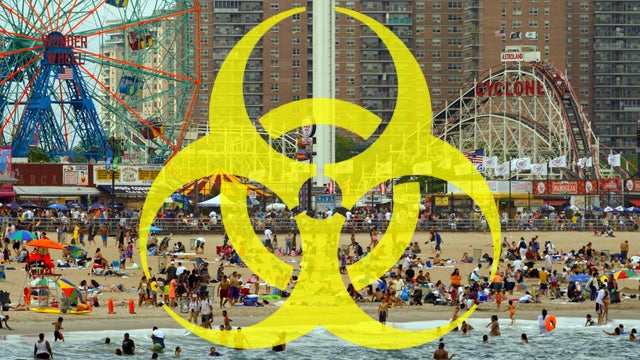On July 12, a group of New York City designers celebrated the successful close of a Kickstarter campaign. Exceeding their goal, they raised $273,000 to build “+Pool,” a that they plan to float in the East River. The idea: filters integrated into its structure will remove harmful bacteria and contaminants in the water, making the pool safe for swimmers.
Regardless of whether this concept ever becomes reality, it begs the question: Is the East River really that polluted? The short answer is no. But there are some important caveats. Herewith, a survival guide for swimming in Gotham.
You should know, first of all, that according to the city’s Department of Environmental Protection, no part of the Inner Harbor (this includes the East River, Hudson River south of its confluence with the Harlem River, and the Upper New York Bay) is safe for swimming, based on water quality standards set by the state’s Department of Conservation. That’s one reason the +Pool concept is so inviting to New Yorkers who want to splash around outside on a hot summer day. But water quality is by no means a static measurement. If it were, one would never see large, organized swimming events in the East and Hudson Rivers, held by groups such as .
“Considering how many [swimming] events, like triathlons, are held … I am just guessing here, but it can’t be that bad for you,” an employee with the DEP, who requested anonymity, told me.
Gregory O’Mullan is not guessing when he says: “Most of the water quality by Manhattan is quite good during good weather.” That’s because studying water quality in and around the city is part of his job as assistant professor of microbiology at Queens College. He recently , however, that shows there is reason to be very careful about where and when you choose to swim around New York. The research shows a strong correlation between the presences of Enterococci, a bacteria found in untreated sewage, and antibiotic-resistant bacteria associated with superbugs.
Here’s how to avoid all of those nasty pollutants:
1: Understand why and how water quality is sometimes poor. NYC, like many old U.S. cities, has an antiquated sewage infrastructure that combines waste from buildings with stormwater runoff in the same system. Given that, and the population explosion the city has seen since its founding, it does not take much of a storm for the quantity of sewage to overwhelm water treatment plants. When that happens, some of the combined runoff and sewage is diverted away from the plants—and it goes straight into the rivers and bay! This effluent, called combined sewage overflow (CSO) does get diluted and dissipates before long. But swimming after a rain storm is never a good idea.
“I’ve spent years dealing with New York water quality and I am shocked by how many New Yorkers don’t know about CSO. People don’t get it. Until they do, we have to be careful about opening up things for recreation,” says O’Mullan. Thus, the official word from the DEP is “stay out” because the water quality is sometimes high, sometimes low.
2: Educate yourself. In May, a new right-to-know law passed that requires publicly-owned sewage treatment plants and publicly-owned delivery systems (pipes and pump stations) to notify the public when untreated water is discharged into state waterways. You can check the DEP’s website for . You can also sign up for text or email alerts from the . But the notification systems are far from perfect, reliable or efficient yet, argues O’Mullan. Local clean water advocacy group Riverkeeper is to include privately-owned wastewater treatment plants and delivery systems. It argues that information about hazardous water conditions should be as accessible as storm warnings, amber alerts and similar public safety systems.
There is, however, a wealth of data about the Hudson estuary available online, thanks to Riverkeeper, which regularly checks post-storm water quality at 75 different locations. You can narrow in on the ones you’re interested and also download its yearly water quality report.
3: Be selective. While water quality ebbs and flows with stormwater runoff, there are many places you’re best to avoid. Industrial, inland waterways used for shipping are generally unsafe – not just due to poor water quality but also boat traffic. I’d avoid jumping in right next to a water treatment plant, myself.
4: Consider your health status. The majority of water-borne illnesses are never reported, and because of that there is very little data on the impacts polluted water makes on public health. People who suffer symptoms related to exposure to bacteria while swimming are quicker to blame them on eating bad seafood or some other unrelated cause. If you’ve got a cold or your immunity is somehow compromised, take extra caution about taking a plunge in water, even if you can’t find any alerts from the city.
5: Focus on the big picture. The +Pool project is intriguing, but the longer-term solution to fighting polluted water in NYC is to prevent pollution from entering the waterways in the first place. The city is spending $2.4 billion on a plan to support green roofs, permeable pavement, rainwater catchments and other infrastructure elements that will reduce stormwater runoff from entering the sewage system. Push for these solutions where you can and if you own your home, think about installing your own. “We’re trying to make the city less impervious,” says the DEP employee.
“Ultimately, we should be moving toward the goal of the Clean Water Act: surface waters in this nation should be swimmable, period. That doesn’t mean that in the meantime we shouldn’t be giving people a way to enjoy the resource. If this +Pool does that, wonderful,” says O’Mullan. But information about water quality “should not be an underground knowledge” that only really active swimmers know how to obtain. “We owe people more than that.”


